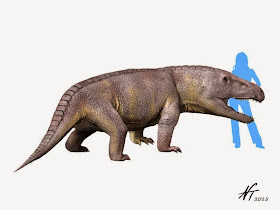 |
| Reconstruction of Erythrosuchus africanus. CZJ posing as scale. |
When it comes to ferocious prehistoric land carnivores, there is one group that never did get much attention outside paleontological circles and it is likely that you never heard of them: the erythrosuchids. This is a pity because, as far as we know, Erythrosuchus africanus was the largest land predator in South Africa during the Middle Triassic period. At an estimated total body length of 5 meters, it possessed a massive one meter long skull equipped with numerous sharp conical teeth, superficially resembling that of big meat eating dinosaurs such as Tyrannosaurus rex. The head was thus disproportionately large with respect to the rest of the body. Unlike T-rex however, Erythrosuchus was quadrupedal, stalking preys on its rather short limbs. The limbs had a semi-erect posture, making it a more efficient runner than most of its contemporaries. Early representations of Erythrosuchus show it with a deep tall snout but modern reconstructions based on the discovery of a complete skull, indicate that it had a more tapered face similar to other erythrosuchids.
The creature has been first described by Scottish paleontologist Robert Broom in 1905 from fragmentary and poorly preserved remains (on a side note, Broom became famous for his later discoveries of early hominid fossils including Paranthropus robustus). Erythrosuchus (the name means “Red crocodile”) is today known from a number of specimens all relatively incomplete but enough to provide a good picture on what the animal may have looked like in real life. All the fossils were unearthed from the upper layers of the so called “Cynognathus assemblage zone”, Upper Beaufort Series, of the Karoo basin of South Africa and date from the Early Middle (Anisian) Triassic period (~245 MYA). Erythrosuchus was therefore contemporary with the cynodonts Cynognathus, Diademodon and Trirachodon and the large plant-eating dicynodont Kannemeyeria, the latter representing its main meal in all probabilities. Other representatives of the Cynognathus assemblage zone fauna are the small theriodont Bauria, the agile archosauriforme Euparkeria, the early rhynchosaurs Howesia and Mesosuchus and the big capitosauroid amphibians such as Watsonisuchus.
The erythrosuchids represent the first radiation of large terrestrial carnivores within the Archosauriformes. They were not quite archosaurs (the higher clade that includes crocs, dinosaurs and birds) but very close relatives. Erythrosuchids appeared in the late Early Triassic period and survived to the end of the Middle Triassic period and had likely a worldwide distribution. Erythrosuchus was the largest among them. The most primitive erythrosuchid is the medium-sized long snouted Fugusuchus hejiapensis from the Heshankou formation (Olenekian) of the Shanxi province of China. Others representatives include Garjainia prima from the Yarenskian horizon (Olenekian) of the Orenburg region of Russia, Vjushkovia triplicostata and Uralosaurus magnus both from the Donguz Formation (Anisian) of the Orenburg region of Russia, Shansisuchus shansisuchus and Guchengosuchus shiguaiensis, both from the upper Ermaying Formation (Anisian) of the Shanxi Province of China. Chalishevia cotburnata from the Bukobay Formation (Ladinian) of the Orenburg region of Russia, is the last known member of the group. It is conjectured that the erythrosuchids went extinct because they were outcompeted in their ecological niche by more efficient archosaurian predators such as the Rauisuchians.
References:
Cruickshank, A. R. I. (1978). The pes of Erythrosuchus africanus Broom. Zoological Journal of the Linnean Society, 62(2), 161-177.
Gower, D. J. (1997). The braincase of the early archosaurian reptile Erythrosuchus africanus. Journal of Zoology, 242(3), 557-576.
Gower, D. J. (2001). Possible postcranial pneumaticity in the last common ancestor of birds and crocodilians: evidence from Erythrosuchus and other Mesozoic archosaurs. Naturwissenschaften, 88(3), 119-122.
Parrish, J. M. (1992). Phylogeny of the Erythrosuchidae (Reptilia: Archosauriformes). Journal of Vertebrate Paleontology, 12(1), 93-102.






